
by Ben Zackheim | Mar 26, 2014 | Book Promotion, Writing |
Goodreads giveaways are a wonderful way for authors to reach potential readers. Why? Because when you give away your book on Goodreads, you’re placing all of your hard work in the hands of someone who wants your book and wants to enjoy it. That last part of the sentence is important. Everyone knows that Goodreads is filled with readers. But one of the unspoken benefits of Goodreads is that people on the site are predominantly kind and supportive. Yes, there are exceptions. But people want to enjoy the books they read. This means you’ll find readers and they’ll be on your side from the get-go.
When you give away a book it’s different than giving away an app, for instance. Books speak to our hearts, minds, senses, emotions. By giving away our story we’re already ahead of the mad rush for people’s hearts that other businesses strive for.
The second biggest benefit of Goodreads giveaways is powerful. If you’re giving away a pre-release book, Goodreads will email many of the contest entrants with news of your book launch. More on that below.
Before you can tackle any of the steps here, you’ll need to sign up to be a Goodreads Author.

This requires you to have a book in their system. You can add your book easily. Just make a simple request to a Goodreads Librarian.
So once you’re an author with work on the site, here’s how you set up Goodreads giveaways:
1) Go to www.goodreads.com and sign up or sign in
2) Click on Explore in the upper right. Then select “giveaways”.
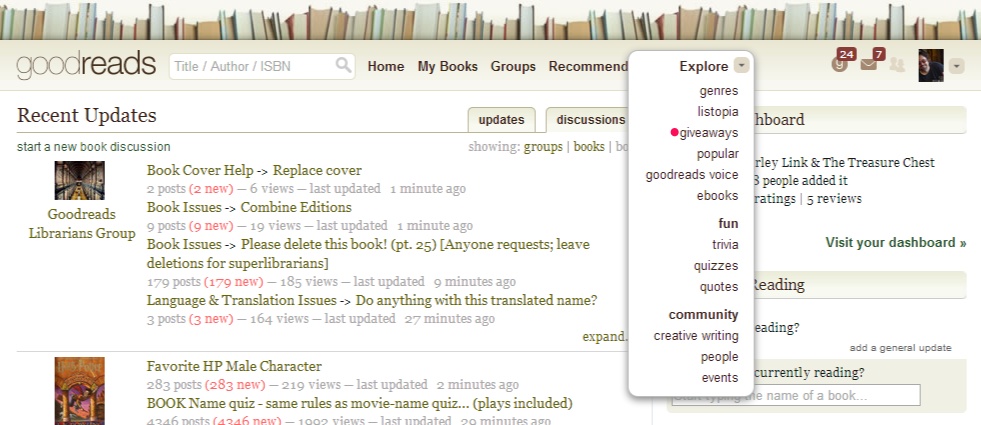
3) You’ll see a list of current giveaways. If you’ve signed up as a Goodreads Author you’ll see “List a Giveaway”. Select it.
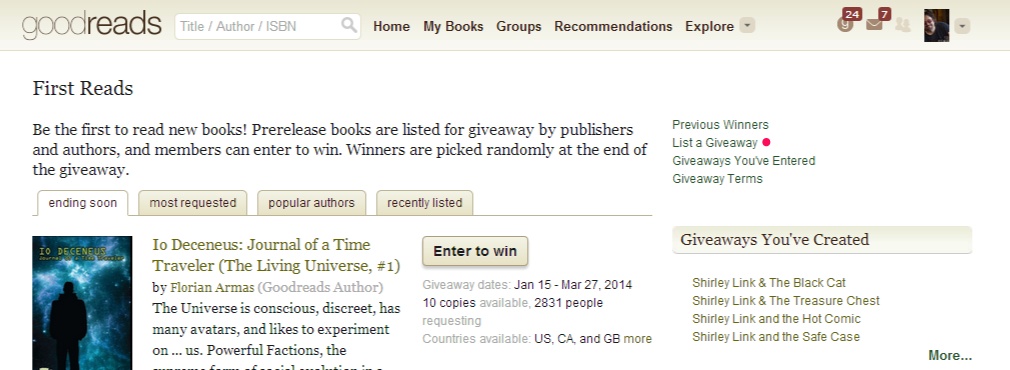
4) Here’s the listing page at last!
Look below the image to get the run-down.

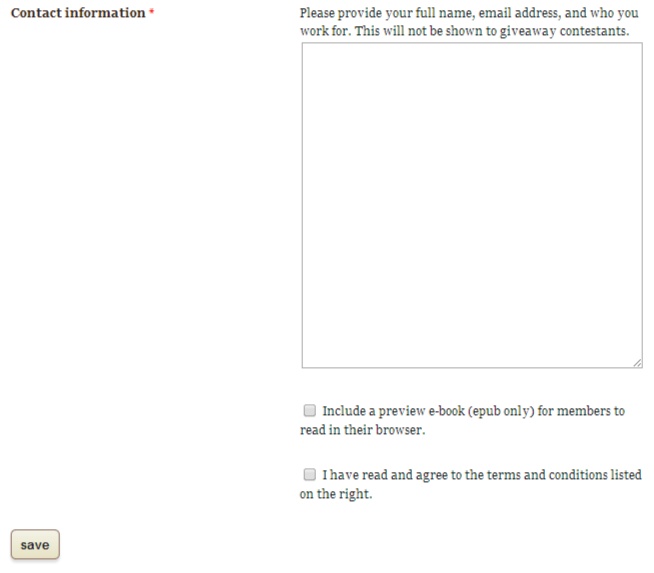
The “gotchas” and best practices are as follows:
-
Be sure to make the contest last a full month. Any less and you’re missing out on potential readers. In general, you’ll see the hugest spike in entrants as the contest deadline approaches, so fret not if things start slow!
-
Try to do the contest a full 2 months before the book launch. So when the contest ends you’ll still have a month to get feedback and reviews from your winners. And they’ll feel special that they got a book a month before it came out.
-
Enter your ISBN or ISBN13 in the field. If you only have an ASIN (Amazon’s ID format) then click on the “Switch to Book ID” link on the right side of the text entry field.
-
Make the description a kick-ass, direct pitch. The better the description, the more entrants you’ll get, guaranteed.
-
Goodreads likes to have authors give away 50 books. I agree that it’s a good number if you can afford it. I’ve done 10 and been happy with the results. However, I plan on following their advice with my next giveaway for The Camelot Kids. 50 copies, here I come!
-
If you don’t have a publisher then just enter your own site’s url. If you don’t have a site, please build one.
-
Choose the countries where you think your book will resonate. It’s a pain to send books internationally, but worth it if you can grow your global readership.
-
Tags are a whole post unto themselves. Enter terms that you believe apply to your book. You can use genre terms (horror, scifi), popular terms (Sherlock, Chicago Bears) or whatever comes to mind. The tags will help entrants choose the book that’s right for them.
-
The contact info is just asking you for basic info. Don’t worry about it. Just write something like “[Name], [email]. I’m the author of the book, [book name]
-
You can include an excerpt of your book for entrants to read. I’d advise doing this because the more people who enter who really WANT to win your book, the better your buzz will be.
Agree to the terms. They’re perfectly reasonable. Here they are for your convenience:
-
You agree to supply the indicated number of books on the date the giveaway ends.
-
Goodreads will list (for free) the giveaway book on the giveaways page.
-
Goodreads will collect interest in the book, and select winners at our discretion. Our algorithm uses member data to match interested members with each book.
-
After the giveaway stop date, click the name of your giveaway (listed under “your giveaways” on the main First Reads page) to see the list of winning addresses. You will also be emailed a list of winners. You are responsible for shipment of the books. Failure to do so will result in us not inviting you over for cake ever again.
-
You agree not to store the winners’ mailing addresses and not to use the winners’ addresses for anything other than sending them the indicated book.
-
Winning members are encouraged but not required to write a review of the book they receive.
-
Ebooks are not allowed. Every winner must receive a physical copy of the book.
Once you’ve started the contest you can retrace Steps 1-3. Notice the area on the right-hand side of the page that reads “Giveaways You’ve Created”? That will give you quick access. You can also find the contest listed on your Goodreads Dashboard
Now here’s the wonderful part. Everyone who enters your Goodreads giveaway will be opted-in to receive an email from Goodreads on the release date. That’s why they ask for the launch date of your book on the form above! In my experience about 75% of the entrants stay opted in.
That’s it! Now you need to promote the contest. That includes posting the Goodreads giveaway on linky (contest) sites and, yes, leveraging Goodreads advertising. I’ll post about that soon.
The final bit of usefulness comes from Goodreads itself. This slideshow is gold.
You might also find the following posts useful:
Does advertising on Goodreads work?
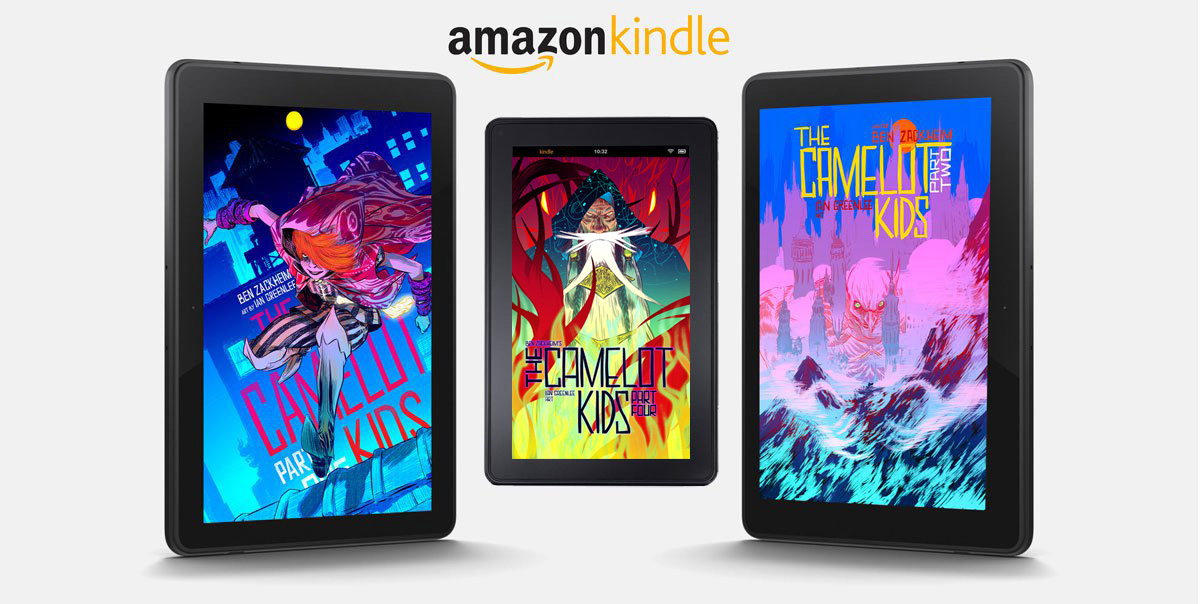
by Ben Zackheim | Feb 19, 2014 | Book Promotion, Writing |
A step-by-step guide, with best practices!
Yup. Blog posts about Amazon KDP Select free promo days are as common as bad drivers on I84.
But I want to do something a little different here. I want to lay out steps and include details about why they are important. I’ll also give you a basic overview of boosting posts on Facebook. These days it’s best to spend five bucks to get the word out.
Once you sign up for KDP Select and figure out what you can do with your exclusive Amazon ebook, you may find a small bump in the road. Actually it may look more like a big, honking wall. The wall is spray painted with large words…
“Now what?”
Here’s what.
1) Decide why you’re doing the KDP Select free promotion days. Don’t just do it to see what happens. I can tell you what happens. Lots of people download your book and add it to their vast library. That plus $17 will buy you a coffee.
Here are some great reasons to do a free giveaway that will actually add some momentum to your efforts:
-
You want the reader to buy the next book in the series. Provide a sample of the next book in the back of the book you’ll be promoting. Provide a link to buy the next book too. If you haven’t done this already, it’s a good idea.
-
You want the reader to buy another book you wrote that is not in the series. Same as above.
-
You want newsletter sign-ups. Definitely recommended if you don’t have any other books available to buy, because this way you minimize the risk of losing them before your next book comes out. People forget things. Even authors they enjoy.
-
You want reviews. Make a level-headed case at the back of the book for writing a review. I lifted my copy from David Gaughran:
“Word-of-mouth is crucial for any author to succeed. If you enjoyed the book, please leave a review on Amazon. Even if it’s just a sentence or two. It would make all the difference and would be very much appreciated: [link to book on Amazon]”
For your first promo I don’t believe you should shoot for more than one of the above goals. Why? It’s hard enough to track progress on one front, much less several. You can always adjust your tactics for the next free promo.
Once you’ve chosen your general goal, choose a specific one. Are you going for sales of the next book in the series? Great! How many do you want to sell? Just guess. Set a goal and be ready for failure or success. Both can be daunting, but it’s essential to measuring the success of your effort.
2) Decide how many days you want the free promo to run. I suggest a minimum of two. This way you can spot whether downloads are accelerating over a substantial period of time (implying a hunger for your book and/or wise choices on the marketing front) or not (implying you’ve missed the mark on marketing).
My opinion is that five days is too long. Especially if this is your only book. Why is that? Because free promo days are a great way to get people to give you a try. If you don’t have another book to sell them then you’ve lost them.
Also, five days is too long because you don’t want everyone who WOULD download your book to see it and download it. You want to leave some room for word of mouth to set in. The longer you keep the book free, the more likely you are to exhaust your potential audience in one go. Now, if you want to just get maximum exposure then five days is an option. Just don’t expect too many sales after the five days is over. You’ve gotten on their Kindle, and now you have to hope they convert to other books in the series or other titles you’ve written.
3) Buy one guaranteed spot. If you can avoid it, do not choose a date for the promo days first. Please. Choosing the date first means you’re setting something in stone before you know the availability of your marketing options (i.e. Bookbub, Bookgoodies, etc.)
So first, choose one of these sites to buy a guaranteed spot.
Bookbub
Booksends (formerly Bookblast)
Free Kindle Books and Tips
BookGoodies
AskDavid
Manybooks
These are the top-notch options for your free day advertising. Choose one, secure a date, and then choose more from this category if you can afford it, and if they can accommodate your dates. Bookbub is tough to get on. They may turn down your money. But one or two of these sites will be happy to take that heavy dough off your hands. I’ve had an especially impressive result from Manybooks. Shirley Link & The Safe Case hit the top 500 Free list on Amazon and it took four days to settle down. Highly recommended.
4) Make a list of friends you can count on to share and bug ’em. Prep an email to them. You’ll send it out a day or two before the promo.
Dear friends!
I apologize for the group email but I want to reach as many people as possible for this. I’ll be giving my ebook [book name] away for FREE on [date]! Why free? It’s a limited time deal on Amazon that will expand my readership and give me a chance to find some new fans.
I could use your help on the promo day. Please keep an eye on [Facebook, Twitter]. When you see my announcement, please Like and Share. The sharing part is important since it will help more people see the deal.
That’s it! I appreciate any help you can provide to get the word out. I’ll let you know how it goes!
Sincerely,
5) Tell the following sites about your KDP Select free promotion days. Be sure to track who you’ve told in your app of choice. I use my Google Docs marketing journal (which I’ll write about one day)
Best websites for marketing your Amazon KDP Select free days
You can also use the Author Marketing Club tool to submit. The tool is a little wonky but it works.
6) Now head in and set your free days on Amazon’s KDP Select site.
7) Now go to your social networks of choice.
Twitter. If you have a Twitter Ads account then you can schedule tweets to go out whenever you want. If you don’t have a Twitter Ads account, it’s worth it. It’s free and gives you incredible stats and some useful features. Sign up for Twitter Ads here. (it’s a Twitter-owned service) Some people use Hootsuite or Buffer to queue up their tweets for later. Both are excellent options. Set up seven tweets per day of your promo. Don’t make them all sales pitches. Make them intriguing.
-
Write a riddle.
-
Include an excerpt.
-
Ask a compelling question that your book answers (fiction or non-fiction).
-
Include pics (cover, interiors).
-
Include vids.
-
Include every media you have for your book!
I recommend you buy some ads on Twitter Ads to get the word out. But wait until the next promo. For your first promo, give Facebook some hard-earned cash. They’re getting good at delivering readers to me.
Facebook. Do two posts for each day of the promo. Again, set these posts up ahead of time. You should consider boosting your posts with a $5 spend. It increases awareness of your promo. Just make sure you target correctly and set the post date for the promo date. How do you do that? It’s easy.
Draft your post (please include an image of the book cover to make the post appear nice).
Then click on the Boost Post button at the bottom of the post window.
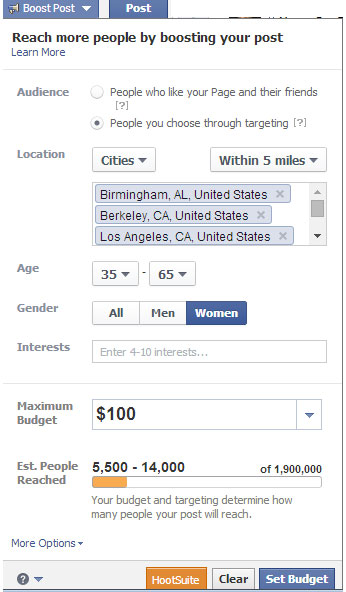
Notice the elegant layout. Amazing how Facebook can make great interfaces when money’s involved, huh?
NOTE: Facebook changes their design all the time. The boosting process will always be similar, though.
Just select “People you choose through targeting” to get the range of options you’ll need. Then fill out information that you think appeals to your target audience. The Interests window is especially important. Put words in there that relate to your genre and book. So if you wrote a book inspired by “It” you could enter “horror, stephen king, violent, scary clowns, it.” Yes, you can get as specific as you’d like. The more specific, the better. With these data in place a whole slew of people who are interested in King, It, and scary clowns will get your ad served to their page.
Some people don’t get great results with Boosts and prefer running Facebook ads. These show up as promoted posts in the feeds of people who you target. The process of setting up an ad is more complex, but you can get the lowdown on how to do it here. If you want to take a course in Facebook ads, sign up for this course.
Pinterest. Post your cover art, interior art and marketing images. The copy should tout the free promo days.
7.1) Add a keyword. Thanks to Julia Derek in the comments section, you get this excellent tip. A couple of days before the promo, head into KDP and add the term “free ebook” to the book’s keywords. It will take several hours to a couple of days to go live. This should help people find you if they’re looking for free ebooks. Don’t forget to remove the keyword term after the promo is over, though.
8) On the first morning of your KDP Select free promotion days, monitor! Go to your marketing journal and see which sites you informed of the free days. Did they post the promo? Not all of them will. Be aware that some sites will post at the end of your day (it’s a big world!) Take note of which ones posted. You’ll want to have that list handy for the next promo.
Go to the site(s) where you paid for promotion and make sure you got what you paid for.
Post the deal to these promotional sites. They only accept additions on the day of the promo.
Addicted to eBooks
Snicks List
Send out an email to your friends, reminding them and offering some new details/news that will make the email worth a read.
Hi all!
As I mentioned, my ebook is free for today on Amazon! Please share the post on your timeline. If you don’t see it, here’s the url.
[insert url for shared post, tweet, etc.]
Thanks so much! I checked my dashboard and have [number] downloads so far. So excited.
Sincerely,
If you’re happy with the results you can post about your success on social networks. It might be nice to send a final email with the good news if you feel like that’s a good idea.
And, of course, head to Amazon KDP to check on the progress. Watch the downloads roll in! It’s fun. Don’t forget to eat.
9) If downloads accelerate on day two, consider adding another day to your promo. Increased interest in your book over a 48 hour period may be a sign that you’ve broken through to a larger audience than your genre warrants. In other words you may have broken into Amazon’s “mainstream” a little bit. If this happens then adding a day will allow for you to capture a much wider audience. Ideally, you’ll go back to charging for the book right when the interest peaks. This way you’ll pick up sales from people who were interested enough to pay for your book.
10) Was it a success? You should keep promoting for a few days after the promo is over. Tout your rise in the rankings, new reviews or whatever stands out as a positive result. But also evaluate the performance of your campaign. Remember how you set a specific goal for your promo? Did you meet it? Exceed it? Give the readers a couple of weeks to show their intent. It takes a while to read a book for some of us!
Take a realistic look at your results. Gauge what went right and wrong with the promo (you will see what worked and what failed). Write these down. Don’t assume you’ll remember because you might not, which means you learned nothing. With all this data, draft a plan for the next promo. And congratulations! You’re on the road to getting much better and being more comfy with marketing! No small task, friends.
Let me know how your promo goes.
[jetpack_subscription_form]
You may also like:
Amazon has a bridge to sell ya!
The $1.1 Million question: Is KDP Select worth it?
by Ben Zackheim
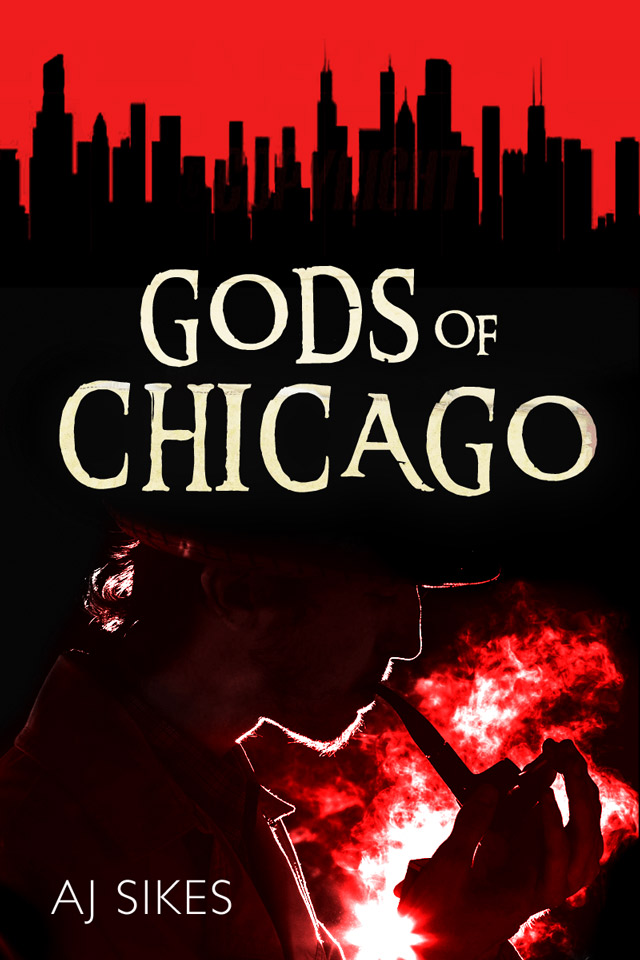
by Ben Zackheim | Feb 11, 2014 | Writing |
Ever thought about serializing your novel, or writing a serial from scratch? Yeah, me too. I’d like to welcome AJ Sikes to the blog with his post on serialization.
Enjoy, and please let us know your take on serialized stories.
Here’s Mr. Sikes!
Hello Everyone!

Many thanks, first of all, to Ben for offering a guest spot on his blog. This marks the second post of my tour promoting Gods of Chicago, a noir urban fantasy that was released in serial format and will soon be available in omnibus and POD editions (release date Feb. 14th!) My first post on this tour was at Zoë Markham’s blog where I talked about the decision to go serial.
Getting down to brass tacks, Ben thought my experience in writing and publishing a serial would be of interest and help to his readers, hence the title of this post. A bit of what I’ll say here is an echo of comments I made on his blog last Monday. But I also share some thoughts on how the serial process can help newer writers test the waters, and especially as regards independent publishing (self and small press).
Lesson One: Write the whole story first.
1. You can put just the first episode out or launch episode 1 and 2 simultaneously, which is what I did. This lets readers get a taste of your writing on the cheap (each episode is just $0.99), and without too much investment of time (each episode comes in at around 15K-20K words, a good read-before-the-lights-go-off chunk of story). Isn’t the point of a serial that it be written in segments? Well, yes. Back when Dickens was doing it, that is how it worked. Edgar Rice Burroughs’ experience with serialization is closer to what I did with Gods of Chicago. Having a full novel ready to go before launching a serial provides a two-fold benefit.
⁃ Based on feedback from your early readers, you may find you need to put the episodes out more quickly than you’d planned.
⁃ Also, serial stories aren’t all the rage these days (though they’re gaining popularity). Readers seem more comfortable getting a story all in one go. For my future efforts, I’ll be doing the full season release, which is what other serial authors seem to be doing now.
2. With the full novel in hand, you lighten the workload when publishing. You’ll tackle all the formatting at once, if you’re doing it yourself. If you’re using a professional formatting service (highly recommended!), they’ll appreciate getting the entire project in one delivery.
⁃ Come publication time, you’ll appreciate having all your ducks in a row.
I had the benefit of working with a publisher who handled cover design, formatting, and uploading of each episode. If you can secure such an arrangement, you should. Unless you’re the kind of person who has access to and can use all the software necessary.
One caveat here: Be wary of sites offering “assisted self-publishing” as these may, in fact, be vanity presses in sheep’s clothing. If you’re paying a publisher for a service, and that publisher is also asking for rights and a share of the royalties, you may want to reconsider signing the contract. Writer Beware is a great resource for new writers looking to avoid pitfalls in publishing. The site is maintained and geared toward the genre fiction community, but writers of any stripe can benefit from a quick read through the archives.

Lesson Two: Invent a time machine so you can read Ben’s blog on KDP Select before you publish
Seriously. ICYMI, Ben did a fantastic two-part blog on the benefits to be had by signing up with Amazon’s KDPS program. Part 2 is here.
I’m a big fan of the transparency among members in the independent author community. Hugh Howey and Joe Konrath in particular have been incredible about sharing the behind-the-scenes details that most authors could only hope to guess at. Even as recently as two years ago. So, I’m happy to share what I’ve learned through my sales, meager though they are.
Kindle users account for the majority of my sales. Month of January sales total 18, split evenly between Amazon.com and Amazon.co.uk, with only episodes 1-3 purchased. Month of February sales total 6 so far, solely from the UK site, with one sale of each episode 1-5.
I’ve sold a total of 3 copies through Kobo. Zilch on B&N and iTunes.
Now, a lot (all) of these abysmally low figures are due to my lack of a significant marketing push, which was, to some extent, intentional. I made announcements in the forums and Goodreads groups I frequent. I talked to potential readers, and I made some noise on Twitter (and thanked every last person who helped boost my signal). But I didn’t advertise or try to flood the airwaves with news about my book.
The goal with the serial was to attract a few early readers and begin building another piece on the platform around my book. I’ve been active online and within the writing community for about two years. I’ve got a personal website for my editing services, which includes a page devoted to my writing. So my efforts at building an author’s platform weren’t restricted to the serial release, and that’s an important point for new authors to consider. It’s what we hear so often…the real work begins after the book is published.
Contrasted with the serial release, for the omnibus/POD release I’m tracking down advertising channels, doing a blog tour (Thanks again, Ben and Zoë!), and plan to use Amazon’s machine to do a lot of the marketing for me through KDPS. I also expect to have monthly deals to plan for, and special promotions to run.
That’s a wrap here. I’m lining up stops on the tour through the month. If any writer- readers would like to host me, I’ll happily provide an edit of your first chapter (up to 5K words) in exchange. The only date I have set is February 24th, where I’ll talk about self-editing tips over at mystery writer Elizabeth Spann Craig’s blog.
If any readers have experience with serial publishing, what did you learn?
BIO:
Aaron Sikes (writing as AJ Sikes) is a writer of weird noir fiction and a freelance editor serving the community of independent authors. His stories have been published by Xchyler Publishing, KnightWatch Press, and Fox Spirit Books. Follow him @SikesAaron and sign up for the Gods of Chicago newsletter to get the latest updates on Mitchell Brand’s adventures and story world extras. If you need editing assistance with your manuscript, please stop by his website.
You might like these posts:
WordPress for writers and authors
Top 5 writing contests
Why you should run a Goodreads contest

by Ben Zackheim | May 16, 2013 | Book Promotion, Shirley Link & The Treasure Chest |
Shirley Link & The Treasure Chest, the third book in my Middle-Grade Mystery series, is out.
But the real good news is that today and tomorrow it is
FRREEEEEeeeeeee
eeeeeeeeeee
….
So go to Amazon and download your own copy. If you like it, give Shirley a review! And spread the word.
Shirley Link & The Treasure Chest clocks in at twice the size of the two previous books. I wanted to dig into the three teen characters some more, and reveal why they are such a great team. Shirley, Wylie and Marie are like the perfect storm. Between them, their loyalty, intellect, strength, bravery and faith in each other makes them the best sleuthing team of all time.
I look forward to writing more about them in the years to come.
Next up in the series is Shirley Link & The Black Cat. It should be a doozy.
Look for it this summer!
From Amazon (Shirley Link & The Treasure Chest):
Shirley Link loves pirates. Well, she loves the idea of them. She wouldn’t like them if they were running up the street stealing bikes, but digging for treasure and swashbuckling adventure are on the top of her to-do list. So when a clue pops up that there’s a hidden pirate treasure under her hometown, Shirley gets to work.
In Shirley Link & The Treasure Chest, the third volume in the critically-acclaimed Middle-Grade Mystery series, our heroine takes on her toughest challenge yet. But this time the stakes are bigger than ever. If she fails to find the treasure, or if it ends up being a hoax, then Shirley’s elderly neighbor, Mrs. Smiley, will lose her home to the bank.
More Shirley, Dad, Wiley and Marie than ever before. That’s right. Even Mr. Link gets to join in the adventure!
Reviews:
Emily Neuburger, Everyday Fun blog, Parents.com
“Shirley Link is a new girl detective series that my daughter is crazy about. This is an amazing series, my friends! Your kids will be hooked and you’ll feel really good about it.”
Edward Hemingway, Author/Illustrator, Bad Apple
“This Virginia Mars for the tween-set is funny, smart, and full of preternatural wisdom.”
PopBop (Top 1000 Amazon reviewer)
“There are early middle grade mysteries out there, but most of them have sketchy characters, and a lot of them plod along fairly predictable arcs. This series has an engaging heroine, a lot of attitude, and a much snappier overall feel.”
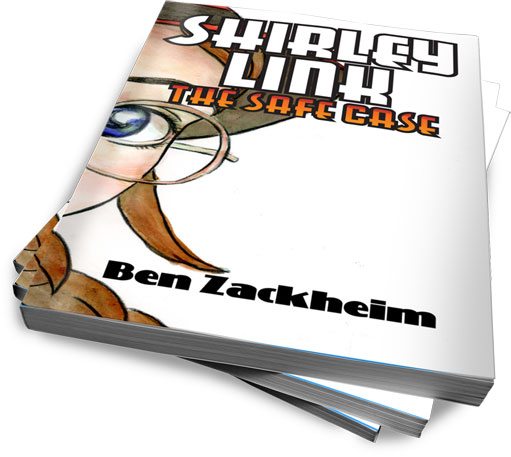
by Ben Zackheim | Feb 18, 2013 | Book Promotion, Writing |
This is a follow-up to a previous post.
I’ve received some feedback on my post about advertising on Goodreads, and it looks like some people are interested in getting into Goodreads, but haven’t made the plunge yet. This sequel is for you!
The thing I like about Goodreads is that it’s filled with readers of all ages. The best way to get to know people who share your tastes is search their groups. I’m still seeking out my niche, but I’ve found lots of helpful and supportive people by just making a page for myself .
If you’re an author you can either “claim” the books you’ve written, or you can upload your book data manually. Once you have an author page with books you can start to find friends by joining group discussions. The best way to sum it up is that Goodreads, while a bit obtuse, is a microcosm of all the reading/writing forums you’ve ever joined on the Web. It’s a wild west of discussions and contests and promotions. The benefit for the author is that you only interact with dedicated book lovers.
Goodreads started a service called Goodreads Self-serve Ads. You can buy, for up to 50 cents per click, ad space on the right or left column of some of their pages. The ads consist of a small image, ad copy and a link to wherever you want. You can set aside any amount as your budget (I chose 10 bucks) and you can track your ad’s performance.
The big benefit of ads on Goodreads is that everyone who sees the ad is more likely than the public at large to be interested in your ad. Still, to ensure you get the most bang for your buck Goodreads allows you to target your ad, meaning you can offer the ad to certain kinds of Goodreads customers. They allow you to show your ads ONLY to people who like (for instance) mystery and YA. You can choose as many genres as you’d like to target, but it’s a fine line you’ll walk in trying to target correctly.If you target too broadly you risk getting people clicking on your ad who are not interested in your kind of book. That’s wasted money. Conversely, if you target too specifically you can filter out perfectly good customers and not see anyone click on your ad at all.
You can also target customers by the author they like, which is an interesting filter that I plan to test out in my next campaign. I need to find out from my current readers who they think I’m similar to!
Advertising on Goodreads
As you can see in the image below, I set my daily budget to 2 bucks. That meant I was planning to pay for a max of 4 clicks on my ad (they charge up to 50 cents per click). I set 10 bucks as the campaign budget, meaning I planned on eventually paying for 20 clicks at 50 cents each. As you can see from the views data, a lot of people had the ad put in front of their faces. A “view” is simply defined as “your ad showed up on the person’s web page”. Goodreads can’t actually guarantee that someone saw and read the ad, they can only tell me that 116,129 people had the ad served to a page that they loaded. Of those 116, 129 Goodreads people, 20 people clicked on my ad. That is .02%

While that sounds miserable, it’s a middling result. A super success would be half a percent point considering that Goodreads doesn’t give you a sexy place on their page to put your ad. In the final analysis I got some exposure for my book series brand, and 20 people showed interest in buying the books.
Lessons learned
And here is where I learned my biggest lesson. Because I don’t have a sale page on my personal website where I can track traffic, I can’t see how many people actually bought the books. I can look at the dates when the ads ran and guess but that’s not a good way to measure these things. My conclusion is that it’s best to have a page with a shopping cart on your own site so you can check the traffic for your site and see “oh, he came from Goodreads.com and he bought a copy on my site.” This way you can see how successful the ad campaign is AND tweak your ad and/or purchase experience next time around.
I’ve learned about a trick and I plan to use it on my next book. According to Tom Corson-Knowles, you can track conversion on Amazon pages by placing an image of yourself in your book description. The image should be hosted by you and served from a bit.ly url. The bit.ly url will allow you to go to the bit.ly site and check traffic for the link. This way you can find out a bunch of user data on who went to your Amazon book page from Goodreads. I haven’t tried this on my Amazon profile because I use Amazon’s Author Central, which does not allow html in their profile form. However, if you are on KDP and have not signed up for Author Central, you CAN use the KDP profile form to enter html, including the bit.ly link. There are some tricks to it and I advise that you buy the three dollar book on Amazon, or borrow it if you’re on Amazon Prime. It’s worth it. It appears that Amazon has changed their policy. I tried to use this trick on a new book using KDP and my html was rejected. As of now, I’m not aware of a way to see traffic to your Amazon page.
Goodreads, for their part, advises ad buyers to make their ads link to the book’s Goodreads page. The Goodreads customer likes their ads to stay within the Goodreads ecosystem because they’re loyal and enjoy the experience.
I saw an uptick in my ads’ performance (known as CTR, or “click through rate”) when I did two things:
- Updated the copy. I went for the soft sell, instead of the hard sell. I toned down the language and removed the “Get the book for Xmas”-type wording. The hard sell doesn’t work well on Goodreads.
- I changed the ad so it linked to Goodreads instead of Amazon. This made the link at the bottom of the ad read “Goodreads” instead of “Amazon” which, again, appears to be what Goodreads customers prefer.
I hope this post now makes it clear what the benefits of Goodreads is as a platform and as a place to advertise.
by Ben Zackheim













